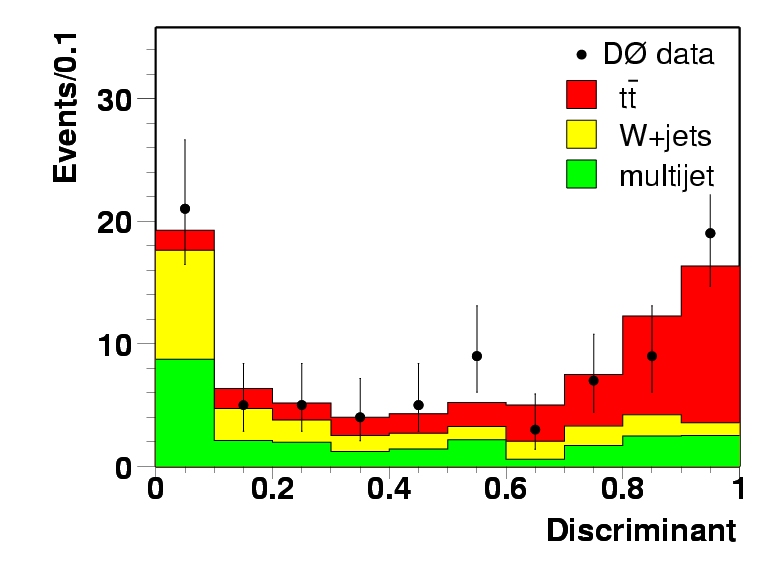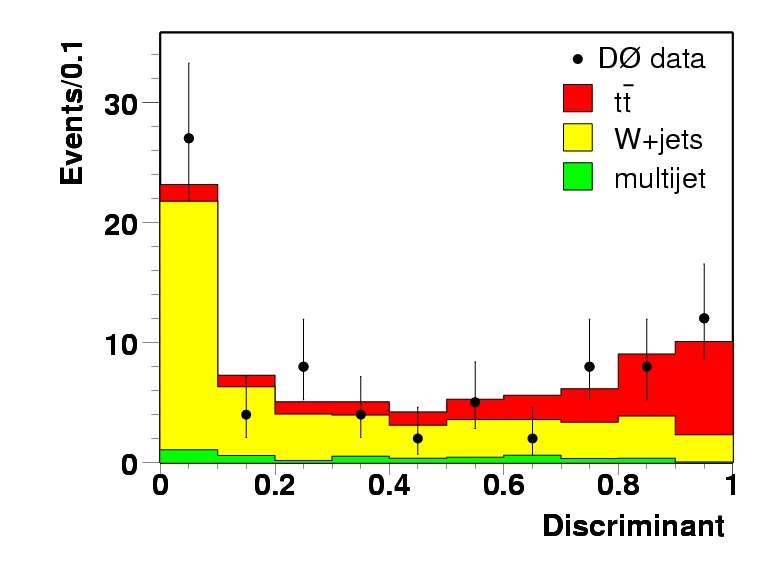Measurement of the top quark pair production cross section based on
lepton+jets event kinematics
The full paper is available
here.
What is the top quark ?One of the earliest questions
pondered by mankind is what our world is made of or, alternatively, what are the
building blocks of the universe. This question has had many different answers as
science explored matter to ever smaller scales searching for its fundamental
constituents.
Present knowledge of the building blocks of matter and their interactions is
described in the so called "Standard
Model" (SM). Within this framework, matter is comprised of six leptons
and six quarks,
and the interactions among them are mediated by the exchange of other particles,
called gauge bosons.
Quarks and leptons are assigned to three "generations",
according to their hierarchy in mass.
The sixth quark, called the "top" quark, was discovered
only 10 years ago at the Fermi National Accelerator Laboratory (Fermilab) by the
CDF and DØ experiments, 20 years after being
predicted by the SM. The top quark is extremely heavy for a fundamental
particle: it is about as heavy as a gold nucleus, and it decays
very rapidly before it can form any bound
state. This feature, which is not shared by any other quark, provides a
unique opportunity to study directly the decay of quarks. Also, it is thought
that the large mass of the top quark is intimately connected to the
mass-generating process within the SM, described via exchanges of the Higgs
boson. As a result, measurements of the top quark mass provide predictions
of the mass of the yet undiscovered Higgs particle. These properties make the
top quark a unique test
stand for the SM.
Top quark production and decayIn the SM, top quarks are
predominantly generated in pairs via the strong
interaction, that is, the top quark (t) is most often produced together with
its antiparticle,
the antitop quark (t¯). Both the top quark and the antitop quark decay into a
lighter quark and a W boson (carrier of the weak
force). Since W bosons can decay in different ways, the final signature
of the top quark pair decay depends on the decay mode of the two produced W
bosons. The possibilities are:
- both W bosons decay into leptons (≈10% of the time),
- one W boson decays into leptons, the other decays into a quark-antiquark
pair (≈44% of the time),
- both W bosons decay into quark-antiquark pairs (≈46% of the time).
Our analysis focuses on the second case, specifically, when one W
boson decays into an electron
(e) or muon
(μ) and its corresponding neutrino
(νe or νμ). In addition to the leptons, four quarks are
produced: two from the original top quark decays and two from the second W
boson. The quarks form collimated particle
showers that we refer to as "jets", hence giving the studied decay channel
the name "lepton+jets".
Finding the top quarkAt the Tevatron,
top quark pairs can be produced
in proton-antiproton collisions, and their decay products observed in the DØ detector. Each recorded proton-antiproton
collision is called an event.
Since the production of a top quark pair is a very rare process, the search for
events containing top quark pairs among all the produced events is similar to
looking for a needle in a haystack. Consequently, very elaborate data-analysis
methods are required to separate the desired events from background.
In accordance with the above description of the lepton + jets signature of
the top quark pair decay, we require one energetic electron or muon in our
events, together with at least four jets. Since neutrinos interact exceedingly
weakly, they traverse the detector undetected. This causes an apparent
imbalance in momentum conservation in the event that we also require to
observe. After this selection, there are two main sources of background that can
mimic a top quark pair decay:
- The production of multijet events, where one jet is misidentified as a
lepton, and the imbalance in momentum is produced by mismeasurement due to
imperfect detector resolution.
- The electroweak
production of a W boson together with jets, in which the W boson decays into
leptons.
Multijet events can be suppressed by applying stringent
quality criteria to the observed leptons. The remaining background can be
distinguished from signal by exploiting specific kinematic properties of top
quark pair events compared to background – for example, due to the large top
quark mass, its observed decay particles are more energetic than the particles
in a non-top event, and since the top quark pair is produced mainly at rest, its
decay particles will be emitted more isotropically, whereas the particles in a
typical background event tend to be emitted in a direction close to the initial
proton-antiproton axis. Such differences between signal and background can be
combined into a discriminating likelihood variable that will tend towards values
of 1 for signal events and 0 for background events. By comparing the shape of
distributions in this variable in the selected data with expectations for signal
and background, obtained from simulations or special data samples, we can
extract the amount of top quark, W boson and multijet events that maximise the
probability to be compatible with the observed distribution. The result of this
determination is shown in the figures below for events containing electrons
(left/up) and muons (right/down).


The resultThe goal of our measurement is to determine
the rate at which top quark pairs are being produced and to compare our
observation with the SM prediction. In analogy with a dart-game, where the rate
of hits depends on the size of the dart board, we use a cross section in units
of area that provides a measure of the production rate for a particular process:
1 barn (b) = 10-28 m2.
As already mentioned, the production cross section for top quark pairs is
tiny. The total proton-antiproton cross section is 61 millibarns (1 mb =
10-3 b), whereas the SM expectation for top quark pair production is
6.8 picobarns (1 pb = 10-12 b), 10 orders of magnitude lower than the
total proton-antiproton interaction or cross section. Taking into account the
size of the total data sample, the inefficiencies (losses) due to our selection
criteria, and the fraction of events in which a top quark pair leads to an
electron+jets or muon+jets final state (17% each), we obtain the total top quark
pair production cross section from the determined number of signal events of 6.7
pb ± 1.4 pb, where the 1.4 pb reflects statistical uncertainty of the small
event sample. This is in very good agreement with SM expectations. In addition,
the individual cross sections for the electron+jets and muon+jets data agree
with each other and with predictions.
OutlookUsing the selections for top quark events
described above, properties of the top quark – such as its mass – can be also
studied. Other decay channels of top quark pairs are also being checked for
agreement with SM predictions. By refining our analysis methods, and using the
continuously accumulating data (a data sample at least a factor of 20 that used
in this analysis is expected to be available by 2009), we are moving towards
precision measurements in top quark physics, probing the validity of the SM and
looking for new discoveries.
If you have any questions about this analysis, please contact the primary
authors C. Gerber, T. Golling, G. Otero, M.-A. Pleier, E. Shabalina and
J.-R. Vlimant.



